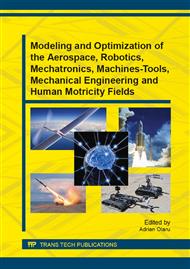[1]
C.A.M. Doorenbosch, J.J.M. Mouritis, H.E.J. Veeger Harlaar J., F.C.T. van der Helm, Determination of the axes of rotation about the shoulder during elevation. Journal of Orthopedic & Sports Physical Therapy 31, (2001), p.133–137.
DOI: 10.2519/jospt.2001.31.3.133
Google Scholar
[2]
N. Klopcar, M. Tomsic, J. Lenarcic, A kinematic model of the shoulder complex to evaluate the arm-reachable workspace, Journal of Biomechanics 40, (2007), p.86–91.
DOI: 10.1016/j.jbiomech.2005.11.010
Google Scholar
[3]
J.M. Hollerbach, T. Flash, Dynamic interactions between limb segments during planar arm movement, MIT Artificial Intelligence Laboratory (1981).
DOI: 10.1007/bf00353957
Google Scholar
[4]
J. Rosen, J.C. Perry, N. Manning, S. Burns, B. Hannaford, The human arm kinematics and dynamics during daily activities – Toward a 7 DOF Upper Limb Powered Exoskeleton, The 12th International Conference on Advanced Robotics – ICAR 2005–Seattle WA, July (2005).
DOI: 10.1109/icar.2005.1507460
Google Scholar
[5]
G. Hiroaki, K. Mitsuo, Human arm stiffness and equilibrium-point trajectory during multi-joint movement, Biological Cybernetics 76, (1997), pp.163-171.
DOI: 10.1007/s004220050329
Google Scholar
[6]
V. Ng-Thow-Hing, W. Shao, Modular components for detailed kinematic modelling of joints, International Society of Biomechanics XIXth Congress. July 6-11, (2003).
Google Scholar
[7]
D. Drăgulescu, Modelarea în Biomecanică, Ed. Didactică şi Pedagogică, Bucureşti (2005).
Google Scholar
[8]
F.H. Martini, Fundamentals of anatomy and physiology, New Jersey: Prentice Hall (1995).
Google Scholar
[9]
W. Schiehlen, Computational Dynamics: Theory and Applications of Multibody Systems, European Journal of Mechanics A/Solids, 25, (2006), pp.566-594.
DOI: 10.1016/j.euromechsol.2006.03.004
Google Scholar
[10]
A. Shabana, , Dynamics of Multibody Systems, 3rd Edition, Cambridge Univ Pres (2005).
Google Scholar
[11]
M. S. Tudoran, D. Ganea, E. Mereuta, C. Mereuta, Experimental research regarding muscles activity, Annals of Dunarea de Jos, University of Galati, Fascicle XV, ISSN 1454-9832, (2012).
DOI: 10.35219/efms
Google Scholar
[12]
M. S. Tudoran, D. Ganea, E. Mereuta, C. Mereuta, A model for studying the human upper limb kinematics, Annals of Dunarea de Jos, University of Galati, Fascicle XV, ISSN 1454-9832, (2012).
DOI: 10.35219/efms
Google Scholar
[13]
E. Mereuta, M. Tudoran, C. Mereuta, L. G. Ionete, Biomechanical models for the kinematics of upper limb, Annals of Dunarea de Jos, University of Galați, Fascicle II, ISSN 2067-2071, (2011), pp.280-285.
Google Scholar


